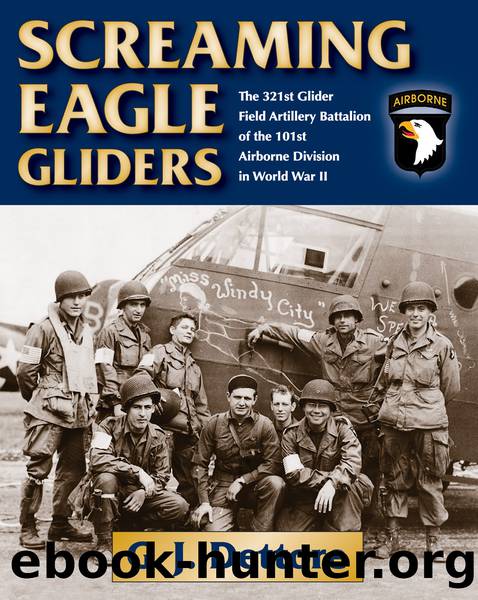Screaming Eagle Gliders by Dettore G. J.;

Author:Dettore, G. J.;
Language: eng
Format: epub
ISBN: 4519242
Publisher: Stackpole Books
The ground crew attached the towrope, Wilkinson continued, and they were pulled slowly to the end of the secondary runway and out to the end of the take-off runway. The glider became airborne first while the C-47 tug was still rolling down the runway. This enabled the glider pilot to trim the wing tabs to compensate for peculiar loads and to get the feel of the craft while the tug plane was still on the runway. Then the glider pilot and tug pilot exchanged hand signals, the tug increased speed, and away they went. The glider pilot tried at all times to fly higher than the tug, in part to stay above the âprop wash,â or air turbulence caused by the tug.
Wilkinsonâs glider was one of the last of the 321st loads to leave England. At takeoff, the weather was overcast, but the clouds were so far up in the atmosphere that they posed no problems. Inland, the visibility was good, and the green, quiltlike patches of the landscape lay beneath them. As far ahead as the troopers could see was a seemingly endless air parade of C-47s towing gliders. This caused a great deal of air turbulence for those who were farther down the line. Some wondered (correctly) if there was an unbroken chain of gliders between them and those now landing on Landing Zone W.
What they could not possibly have known was that their sister battalion, the 907th GFA, was supposed to follow them but had turned back. The code word for turning back, âPennsylvania,â caused all but sixteen of the eighty-nine 907th tugs to return to their base in England. The few that didnât get the message hit fog that caused much trouble. The commanding officer of the 907th, Lt. Col. Clarence Nelson, was one of the glidermen who was unaware of the turnaround and landed in Holland. When his battalion never showed, he believed they were wiped out by the Germans. The rest of his battalion was grounded in England by poor weather until September 21. The 321st was called upon to fill the void.
Wilkinson wrote:
The tug plane went into another cloud and again the tow rope went âthrough the hole in the wall.â We were in a âgray fogâ; the glider pilot had to depend on the âfeelâ of the craft and tension of [the] tug rope for his piloting.
We seemed to be progressing satisfactory [sic] in this cloud when suddenly, we came out into the clear. Where was the tug? Over there, to the left, flying at almost a right angle to our direction. [The] tug plane had swerved suddenly left to avoid a collision. We followed.
Below us was blue; we were over the channel. Into another cloud went the tug. The time in the clouds was becoming longer, and the time in the clear between clouds was becoming shorter. Air turbulence was increasing. Glider ups and downs plus pitching about [were] becoming greater.
We were in another cloud. The tow rope became slack, a
Download
This site does not store any files on its server. We only index and link to content provided by other sites. Please contact the content providers to delete copyright contents if any and email us, we'll remove relevant links or contents immediately.
The Radium Girls by Kate Moore(10910)
The Templars by Dan Jones(4191)
100 Deadly Skills by Clint Emerson(4082)
Rise and Kill First by Ronen Bergman(4014)
The Doomsday Machine by Daniel Ellsberg(3734)
The Rape of Nanking by Iris Chang(3518)
Killing England by Bill O'Reilly(3458)
Hitler in Los Angeles by Steven J. Ross(3441)
Stalin by Stephen Kotkin(3088)
12 Strong by Doug Stanton(3059)
Hitler's Monsters by Eric Kurlander(2734)
Darkest Hour by Anthony McCarten(2649)
Blood and Sand by Alex Von Tunzelmann(2610)
The Art of War Visualized by Jessica Hagy(2413)
Hitler's Flying Saucers: A Guide to German Flying Discs of the Second World War by Stevens Henry(2297)
The Code Book by Simon Singh(2212)
The Second World Wars by Victor Davis Hanson(2136)
Babylon's Ark by Lawrence Anthony(2072)
Tobruk by Peter Fitzsimons(2063)
